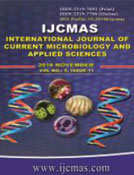


 National Academy of Agricultural Sciences (NAAS)
National Academy of Agricultural Sciences (NAAS)

|
PRINT ISSN : 2319-7692
Online ISSN : 2319-7706 Issues : 12 per year Publisher : Excellent Publishers Email : editorijcmas@gmail.com / submit@ijcmas.com Editor-in-chief: Dr.M.Prakash Index Copernicus ICV 2018: 95.39 NAAS RATING 2020: 5.38 |
Surgical site infections (SSI) are one of the leading causes of nosocomial infections 2-20% which is a major public health problem worldwide. Surgical site infection is defined as infections occurring 30 days within surgery with no implant or with implant within 1 year. SSI is one of the leading causes for mortality and morbidity, leading to increased admission and readmission to the hospital. The study included clinically diagnosed cases of SSI from 122 in patients having sign & symptoms of SSIs as per CDC guide from period of one year, two swabs were collected as per guidelines, one swab for gram stain and second swab for culture on appropriate media. Antibiotic sensitivity testing done as per CLSI guidelines, detection of MRSA done using cefoxitin disc diffusion test. A total of 521 surgeries conducted during the study period and 122 patients were diagnosed clinically as SSI. Out of 122 clinically diagnosed cases 73(59.83%) cases showed aerobic bacterial culture, 34(46.57%) isolates were gram positive organisms and 39(53.42%) isolates were gram negative organism. This study found that Staphylococcus aureus was most common isolate 28(38.35%) followed by Klebsiella 17(23.28%), Pseudomonas aeruginosa 10(13.69%), E.coli (07), Proteus spp. 04 (05.47%), CoNS04 (05.47%), Enterococci 02 (2.73%), Acinetobacter 01(1.36%). All the gram positive isolates were found to be 100% sensitive to Vancomycin, followed by Teicoplanin. Least sensitive durgs were Clindamycin, Ampicillin was found to be only sensitive in 42.8% & 50% respectively. Gentamicin was 100%sensitive in CoNS and Enterococci & 89.82 % in S.aureus. MRSA was found to be 9.58% in our study. Even with the use of prophylactic antibiotics, SSIs are still a real risk and complication of surgery & represent a substantial burden of disease for both patients & health care system in terms of morbidity, mortality & financial burden. So healthcare professionals should consider the factors influencing the wound healing and proper infection control practices and antibiotic policy.
 |
 |
 |
 |
 |